Numerical Study of the Transmission of Exhaled Droplets between the Instructor and Students in a Typical Classroom
Abstract
1. Introduction
2. Scope and Objectives
- To numerically track the spreading of the aerosol particles with time-based on a calibrated CFD model with decent spatial resolution.
- To introduce some well-defined dimensionless parameters that could be used to assess the vulnerability to the exposure of the droplets of aerosols.
- To investigate the effect of adopting different ventilation schemes on the students’ expected exposure to the aerosol droplets.
- To investigate the effect of keeping the entrance door opened or closed on the students’ expected exposure to the aerosol droplets.
- To investigate the effect of droplet size on the students’ expected exposure to the aerosol droplets.
3. Materials and Methods
3.1. Problem Formulation and Assumptions
3.1.1. Problem Formulation
3.1.2. Assumptions
- The particles/droplets are single sized and uniformly distributed; however, the range of particle/droplet sizes from 1 to 5 microns was examined.
- The transmission scheme of exhaled droplets occurs through the speaking process between the infected instructor and the students.
- A simplified “prismatic” geometry for the body of a typical student (sitting on a desk in class) and a typical instructor (standing facing the students) is adopted to reduce computational resources.
- The evaporation effect on the size of bioaerosols is neglected. Several researchers also considered this assumption, such as La and Zhang, 2019 [33].
- The respiratory behavior of the exposed students is neglected. The same assumption was considered by other researchers, an example of those researchers is Zhang et al. 2017 [34].
- The following basic properties of Fluent’s standard air material were used for the continuous phase: air density (ρ) = 1.225 kg/m3 and dynamic viscosity (μ) = 1.84 × 10−5 Pa⋅s.
3.2. Definition of Assessment Indicators
- The normalized average concentration (NAC) is a dimensionless number that gives the average concentration of aerosol droplets received on average by all students normalized by the initial concentration ejected from the infected instructor’s mouth.
- The specific normalized average concentration (SNAC) is also a dimensionless number that gives the average concentration of aerosol droplets received by exposed students only divided by the concentration ejected from the infected instructor’s mouth. SNAC can be calculated as per the following formula:
- The ventilation rate ratio (VRR) is the ratio of the actual total ventilation rate divided by a reference ventilation rate. In this study, the reference ventilation rate was selected to be the minimum ventilation rate recommended by ASHRAE standards [44] (the reference case, R2):
- The exceedance in exposure ratio (EER) is a dimensionless number that can be used to identify the location and degree of a student’s risk of exposure to harmful droplets. In other words, it describes the exceedance or decadence of a student’s exposure to the droplets for a given ventilation rate compared to the corresponding average exposure that is expected in case of a minimum ventilation rate:
- Based on the definition mentioned earlier, the value of EER could be positive, zero, or negative. A positive value means the student exposure exceeds the average conditions, whereas a negative value implies vice versa. Therefore, EER could represent the spatial risk of exposure to the droplets among the students in the class based on their location and the applied ventilation rate.
3.3. Development of Numerical Model
3.3.1. Governing Equations
- Fluid Phase
- (a)
- The mass conservation equation
- (b)
- The momentum conservation equationThe conservation of momentum is described by:
- (c)
- The turbulence transport equationsThe transport equations for the RNG-k-ε turbulent model are given as:
- Particle Phase
3.3.2. Numerical Model Characteristics
3.4. Model Validation
3.4.1. Description of Physical Experiments
- (a)
- First validation experiment
- (b)
- Second validation experiment
3.4.2. Results of Model Validation
- (a)
- First validation experiment
- (b)
- Second validation experiment
3.5. Classroom Case Description
3.5.1. Classroom Layout and Facilities
3.5.2. Ventilating System
3.5.3. Development of Scenarios
3.5.4. Development of CFD Model for Lecture Room
- (a)
- Model Description
- (b)
- Model Discretization and CGI Analysis
4. Results and Discussion
4.1. Induced Air Field by Swirl Ceiling Diffuser
4.2. Aerosol Droplets Tracking
4.3. Discussion
5. Conclusions
- The contour mapping of the EER within the exam room, after 180 s, revealed that the students sitting in front of the instructor, especially in the second and third rows, were more susceptible to infection if the ventilation rate does not exceed the minimum recommended ventilation rate by ASHRAE. On the other hand, and as expected, students sitting beside the wall far from the instructor were not affected.
- The dispersion of the exhaled droplets inside the room was improved significantly by increasing the ventilation rate.
- Increasing the ventilation rate increased the number of affected students. However, it decreased the concentrations to which they were significantly exposed.
- Increasing the ventilation rate decreased the specific normalized average concentration (SNAC) exponentially. Nevertheless, increasing the ventilation rate ratios above three is expected to have a non-tangible effect on reducing the harmful droplets’ exposure. However, more analysis may be required in this regard.
- Keeping the room’s main door open at a ventilation rate ratio of 2 reduced the risk of exposure (to the harmful aerosol droplets) by 26%.
- Based on the SNAC values for the whole body, the large size (5 μm) droplets appeared to be less hazardous as they resulted in an 87% reduction in exposure when compared with the small 1 μm size droplets.
- Some students might be subjected to a high risk of exposure (to harmful droplets) that exceeded 3.5 times the average reference risk in the case of no ventilation.
Author Contributions
Funding
Institutional Review Board Statement
Informed Consent Statement
Data Availability Statement
Acknowledgments
Conflicts of Interest
References
- WHO. Summary of Probable SARS Cases with Onset of Illness from 1 November 2002 to 31 July 2003. Available online: https://www.who.int/csr/sars/country/table2004_04_21/en/ (accessed on 15 August 2020).
- Dawood, F.S.; Iuliano, A.D.; Reed, C.; Meltzer, I.M.; Shay, D.; Cheng, P.-Y.; Bandaranayake, D.; Breiman, R.F.; Brooks, W.A.; Buchy, P.; et al. Estimated Global Mortality Associated with the First 12 Months of 2009 Pandemic Influenza a H1N1 Virus Circulation: A Modelling Study. Lancet Infect. Dis. 2012, 12, 687–695. [Google Scholar] [CrossRef]
- Peck, K.; Burch, C.; Heise, M.T.; Baric, R.S. Coronavirus Host Range Expansion and Middle East Respiratory Syndrome Coronavirus Emergence: Biochemical Mechanisms and Evolutionary Perspectives. Annu. Rev. Virol. 2015, 2, 95–117. [Google Scholar] [CrossRef] [PubMed]
- World Health Organization. WHO Coronavirus (COVID-19) Dashboard. Available online: https://covid19.who.int/ (accessed on 21 September 2021).
- Asadi, S.; Bouvier, N.; Wexler, A.S.; Ristenpart, W.D. The Coronavirus Pandemic and Aerosols: Does COVID-19 Transmit via Expiratory Particles? Aerosol Sci. Technol. 2020, 54, 635–638. [Google Scholar] [CrossRef] [PubMed]
- Burke, R.M.; Midgley, C.M.; Dratch, A.; Fenstersheib, M.; Haupt, T.; Holshue, M.; Ghinai, I.; Jarashow, C.; Lo, J.; McPherson, D.T.; et al. Active Monitoring of Persons Exposed to Patients with Confirmed COVID-19—United States, January–February 2020. MMWR Morb. Mortal. Wkly. Rep. 2020, 69, 245–246. [Google Scholar] [CrossRef]
- Chan, J.F.-W.; Yuan, S.; Kok, K.-H.; To, K.K.-W.; Chu, H.; Yang, J.; Xing, F.; Liu, J.; Yip, C.C.-Y.; Poon, R.W.-S.; et al. A Familial Cluster of Pneumonia Associated with the 2019 Novel Coronavirus Indicating Person-To-Person Transmission: A Study of a Family Cluster. Lancet 2020, 395, 514–523. [Google Scholar] [CrossRef]
- Hadei, M.; Hopke, P.K.; Jonidi, A.; Shahsavani, A. A Letter about the Airborne Transmission of SARS-CoV-2 Based on the Current Evidence. Aerosol Air Qual. Res. 2020, 20, 911–914. [Google Scholar] [CrossRef]
- Huang, C.; Wang, Y.; Li, X.; Ren, L.; Zhao, J.; Hu, Y.; Zhang, L.; Fan, G.; Xu, J.; Gu, X.; et al. Clinical Features of Patients Infected with 2019 Novel Coronavirus in Wuhan, China. Lancet 2020, 395, 497–506. [Google Scholar] [CrossRef]
- Jones, R.M.; Brosseau, L.M. Aerosol Transmission of Infectious Disease. J. Occup. Environ. Med. 2015, 57, 501–508. [Google Scholar] [CrossRef]
- Li, Q.; Guan, X.; Wu, P.; Wang, X.; Zhou, L.; Tong, Y.; Ren, R.; Leung, K.; Lau, E.; Wong, J.Y.; et al. Early Transmission Dynamics in Wuhan, China, of Novel Coronavirus–Infected Pneumonia. N. Engl. J. Med. 2020, 382, 1199–1207. [Google Scholar] [CrossRef] [PubMed]
- Liu, Y.; Ning, Z.; Chen, Y.; Guo, M.; Liu, Y.; Gali, N.K.; Sun, L.; Duan, Y.; Cai, J.; Westerdahl, D.; et al. Aerodynamic Analysis of SARS-CoV-2 in Two Wuhan Hospitals. Nature 2020, 582, 557–560. [Google Scholar] [CrossRef] [PubMed]
- Morawska, L.; Cao, J. Airborne Transmission of SARS-CoV-2: The World Should Face the Reality. Environ. Int. 2020, 139, 105730. [Google Scholar] [CrossRef]
- Mittal, R.; Ni, R.; Seo, J.-H. The Flow Physics of COVID-19. J. Fluid Mech. 2020, 894. [Google Scholar] [CrossRef]
- Van Doremalen, N.; Bushmaker, T.; Morris, D.H.; Holbrook, M.G.; Gamble, A.; Williamson, B.N.; Tamin, A.; Harcourt, J.L.; Thornburg, N.J.; Gerber, S.I.; et al. Aerosol and Surface Stability of SARS-CoV-2 as Compared with SARS-CoV-1. N. Engl. J. Med. 2020, 382, 1564–1567. [Google Scholar] [CrossRef] [PubMed]
- Bourouiba, L.; Dehandschoewercker, E.; Bush, J.W.M. Violent Expiratory Events: On Coughing and Sneezing. J. Fluid Mech. 2014, 745, 537–563. [Google Scholar] [CrossRef]
- He, Q.; Niu, J.; Gao, N.; Zhu, T.; Wu, J. CFD Study of Exhaled Droplet Transmission between Occupants under Different Ventilation Strategies in a Typical Office Room. Build. Environ. 2011, 46, 397–408. [Google Scholar] [CrossRef] [PubMed]
- Richmond-Bryant, J. Transport of Exhaled Particulate Matter in Airborne Infection Isolation Rooms. Build. Environ. 2009, 44, 44–55. [Google Scholar] [CrossRef]
- Wei, J.; Li, Y. Enhanced Spread of Expiratory Droplets by Turbulence in a Cough Jet. Build. Environ. 2015, 93, 86–96. [Google Scholar] [CrossRef]
- Xie, X.; Li, Y.; Chwang, A.T.Y.; Ho, P.L.; Seto, W.H. How Far Droplets Can Move in Indoor Environments? Revisiting The Wells Evaporation? Falling Curve. Indoor Air 2007, 17, 211–225. [Google Scholar] [CrossRef]
- Morawska, L.; Johnson, G.; Ristovski, Z.; Hargreaves, M.; Mengersen, K.; Corbett, S.; Chao, Y.H.C.; Li, Y.; Katoshevski, D. Size Distribution and Sites of Origin of Droplets Expelled from the Human Respiratory Tract during Expiratory Activities. J. Aerosol Sci. 2009, 40, 256–269. [Google Scholar] [CrossRef]
- Chao, C.; Wan, M.P.; Morawska, L.; Johnson, G.; Ristovski, Z.; Hargreaves, M.; Mengersen, K.; Corbett, S.; Li, Y.; Xie, X.; et al. Characterization of Expiration Air Jets and Droplet Size Distributions Immediately at the Mouth Opening. J. Aerosol Sci. 2009, 40, 122–133. [Google Scholar] [CrossRef]
- Kwon, S.-B.; Park, J.; Jang, J.; Cho, Y.; Park, D.-S.; Kim, C.; Bae, G.-N.; Jang, A. Study on the Initial Velocity Distribution of Exhaled Air from Coughing and Speaking. Chemosphere 2012, 87, 1260–1264. [Google Scholar] [CrossRef] [PubMed]
- Zhang, H.; Li, D.; Xie, L.; Xiao, Y. Documentary Research of Human Respiratory Droplet Characteristics. Procedia Eng. 2015, 121, 1365–1374. [Google Scholar] [CrossRef]
- Liu, Y.; Ning, Z.; Chen, Y.; Guo, M.; Liu, Y.; Gali, N.K.; Sun, L.; Duan, Y.; Cai, J.; Westerdahl, D. Aerodynamic Characteristics and RNA Concentration of SARS-CoV-2 Aerosol in Wuhan Hospitals during COVID-19 Outbreak. BioRxiv 2020, 982637. [Google Scholar] [CrossRef]
- Noakes, C.J.; Sleigh, P.A.; Escombe, A.R.; Beggs, C.B.; Sleigh, A. Use of CFD Analysis in Modifying a TB Ward in Lima, Peru. Indoor Built Environ. 2006, 15, 41–47. [Google Scholar] [CrossRef]
- King, M.-F.; Noakes, C.; Sleigh, P.; Camargo-Valero, M. Bioaerosol Deposition in Single and Two-Bed Hospital Rooms: A Numerical and Experimental Study. Build. Environ. 2013, 59, 436–447. [Google Scholar] [CrossRef]
- King, M.-F.; Noakes, C.J.; Sleigh, P.A. Modeling Environmental Contamination in Hospital Single- And Four-Bed Rooms. Indoor Air 2015, 25, 694–707. [Google Scholar] [CrossRef]
- Loomans, M.; de Visser, I.; Loogman, J.; Kort, H. Alternative Ventilation System for Operating Theaters: Parameter Study and Full-Scale Assessment of the Performance of a Local Ventilation System. Build. Environ. 2016, 102, 26–38. [Google Scholar] [CrossRef][Green Version]
- Verma, T.N.; Sahu, A.K.; Sinha, S.L. Study of Particle Dispersion on One Bed Hospital using Computational Fluid Dynamics. Mater. Today Proc. 2017, 4, 10074–10079. [Google Scholar] [CrossRef] [PubMed]
- Zhao, B.; Li, X.; Zhang, Z.; Huang, D. Comparison of Diffusion Characteristics of Aerosol Particles in Different Ventilated Rooms by Numerical Method. ASHRAE Trans. 2004, 110, 88–96. [Google Scholar]
- Zhao, B.; Zhang, Y. Analysis of Particle Pollution in an Office by the Concept of Perceived Particle Intensity. Indoor Built Environ. 2006, 15, 463–472. [Google Scholar] [CrossRef]
- La, A.; Zhang, Q. Experimental Validation of CFD Simulations of Bioaerosol Movement in a Mechanically Ventilated Airspace. Can. Biosyst. Eng. 2019, 5.01–5.14. [Google Scholar] [CrossRef]
- Zhang, Y.; Feng, G.; Kang, Z.; Bi, Y.; Cai, Y. Numerical Simulation of Coughed Droplets in Conference Room. Procedia Eng. 2017, 205, 302–308. [Google Scholar] [CrossRef]
- Chen, F.; Yu, S.; Lai, A.C. Modeling Particle Distribution and Deposition in Indoor Environments with a New Drift–Flux Model. Atmos. Environ. 2006, 40, 357–367. [Google Scholar] [CrossRef]
- Chen, Q. Comparison of Differentk-Ε Models for Indoor Air Flow Computations. Numer. Heat Transfer Part B Fundam. 1995, 28, 353–369. [Google Scholar] [CrossRef]
- Lai, A.C.K.; Chen, F. Corrigendum to: “Modeling of Particle Deposition and Distribution in a Chamber with a Two-Equation Reynolds-Averaged Navier–Stokes model”. J. Aerosol Sci. 2011, 42, 497–498. [Google Scholar] [CrossRef]
- Zhao, B.; Yang, C.; Yang, X.; Liu, S. Particle Dispersion and Deposition in Ventilated Rooms: Testing and Evaluation of Different Eulerian and Lagrangian Models. Build. Environ. 2008, 43, 388–397. [Google Scholar] [CrossRef]
- Zoka, H.M.; Moshfeghi, M.; Bordbar, H.; Mirzaei, P.; Sheikhnejad, Y. A CFD Approach for Risk Assessment Based on Airborne Pathogen Transmission. Atmosphere 2021, 12, 986. [Google Scholar] [CrossRef]
- Shao, S.; Zhou, D.; He, R.; Li, J.; Zou, S.; Mallery, K.; Kumar, S.; Yang, S.; Hong, J. Risk Assessment of Airborne Transmission of COVID-19 by Asymptomatic Individuals under Different Practical Settings. J. Aerosol Sci. 2021, 151, 105661. [Google Scholar] [CrossRef]
- Salmela, A.; Kokkonen, E.; Kulmala, I.; Veijalainen, A.-M.; Van Houdt, R.; Leys, N.; Berthier, A.; Viacheslav, I.; Kharin, S.; Morozova, J.; et al. Production and Characterization of Bioaerosols for Model Validation in Spacecraft Environment. J. Environ. Sci. 2018, 69, 227–238. [Google Scholar] [CrossRef]
- Hu, S. Airflow Characteristics in the Outlet Region of a Vortex Room Air Diffuser. Build. Environ. 2003, 38, 553–561. [Google Scholar] [CrossRef]
- Liu, Z.; Wang, L.; Rong, R.; Fu, S.; Cao, G.; Hao, C. Full-Scale Experimental and Numerical Study of Bioaerosol Characteristics Against Cross-Infection in a Two-Bed Hospital Ward. Build. Environ. 2020, 186, 107373. [Google Scholar] [CrossRef]
- ASHRAE Addendum. Ventilation for Acceptable Indoor Air Quality, ANSI/ASHRAE Addendum p to ANSI/ASHRAE Standard 62.1-2013; ASHRAE: Atlanta, GA, USA, 2015. [Google Scholar]
- ANSYS. Fluent Theory Guide Release 15.0; ANSYS, Inc.: Canonsburg, PA, USA, 2013; pp. 1–814. [Google Scholar]
- King, M.-F.; (Research Fellow, School of Civil Engineering, University of Leeds, Leeds, UK). Personal communication, 1 June 2020.
- Taghinia, J.H.; Rahman, M.; Lu, X. Effects of Different CFD Modeling Apsproaches and Simplification of Shape on Prediction of Flow Field Around Manikin. Energy Build. 2018, 170, 47–60. [Google Scholar] [CrossRef]
- Bonello, M.; Micallef, D.; Borg, S.P. Humidity Distribution in High-Occupancy Indoor Micro-Climates. Energies 2021, 14, 681. [Google Scholar] [CrossRef]
- Cook, M.; Cropper, P.; Fiala, D.; Yousaf, R.; Bolineni, S.; van Treeck, C. Coupled CFD and Thermal Comfort Modeling in Cross-Ventilated Classrooms. ASHRAE Trans. 2013, 119, 1–8. [Google Scholar]
- Zhiqiang, K.; Yixian, Z.; Hongbo, F.; Guohui, F. Numerical Simulation of Coughed Droplets in the Air-Conditioning Room. Procedia Eng. 2015, 121, 114–121. [Google Scholar]
- Journal of Fluids Engineering Editorial Policy, Statement on the Control of Numerical Accuracy. Available online: https://www.asme.org/wwwasmeorg/media/resourcefiles/shop/journals/jfenumaccuracy.pdf (accessed on 16 September 2021).


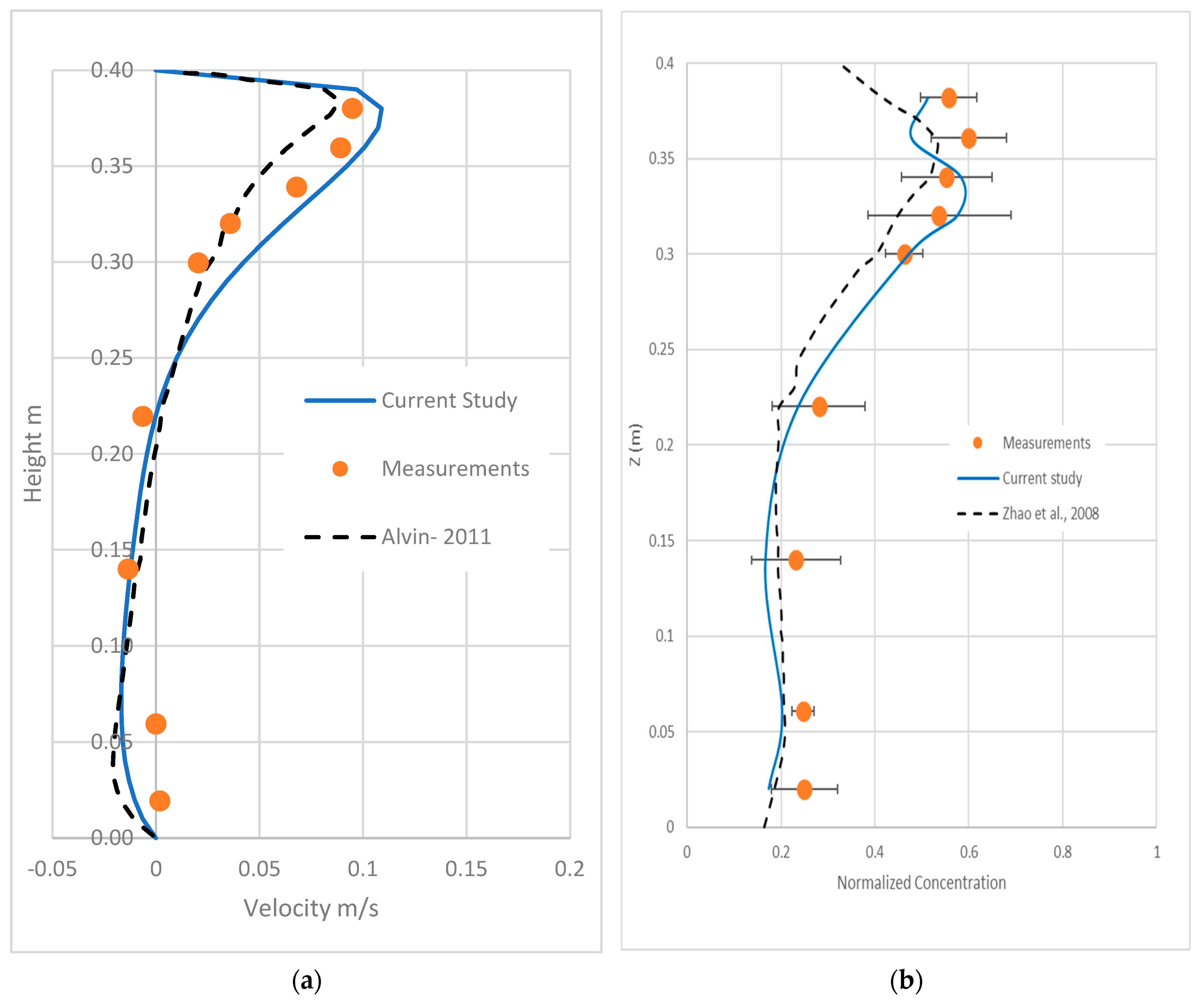
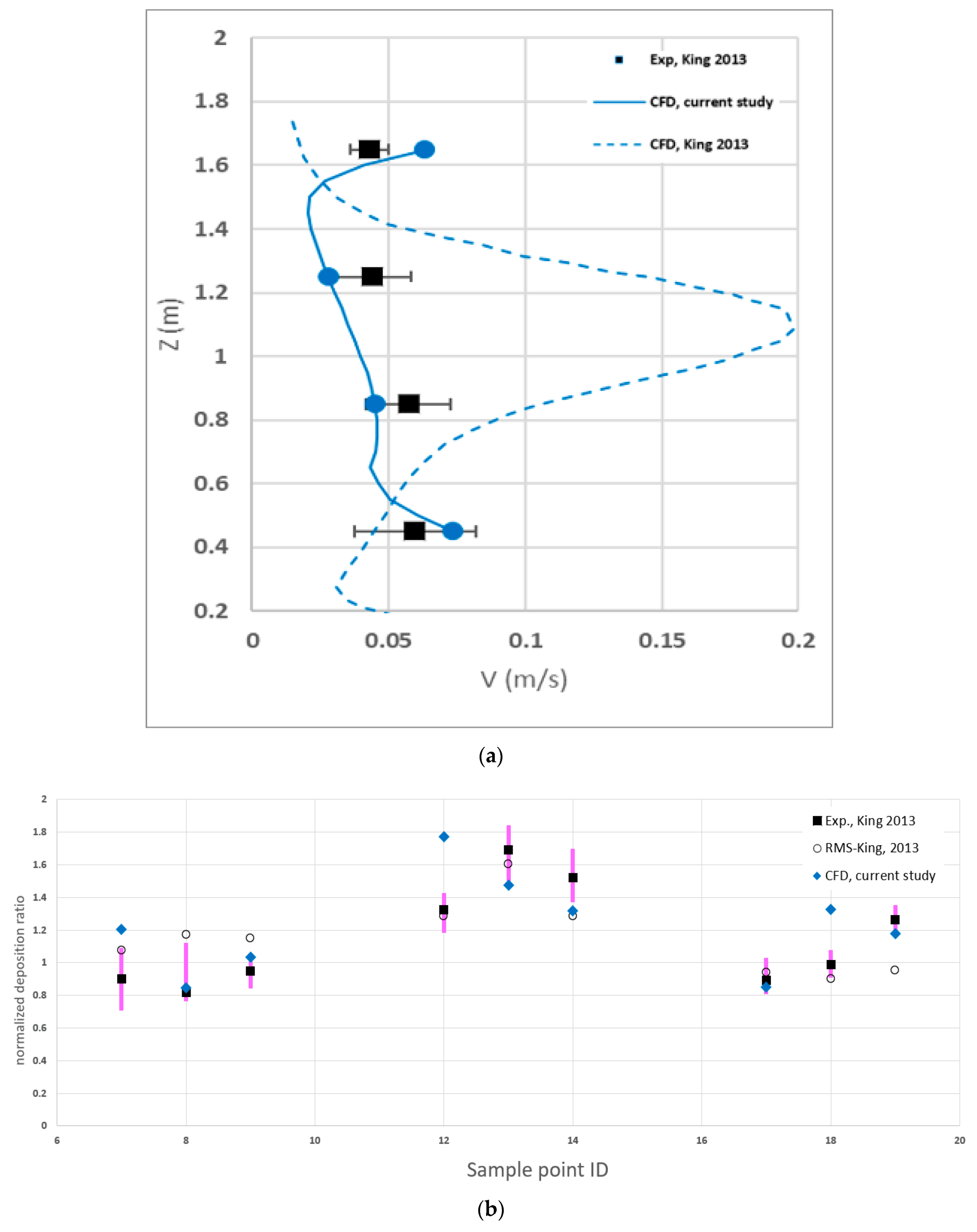
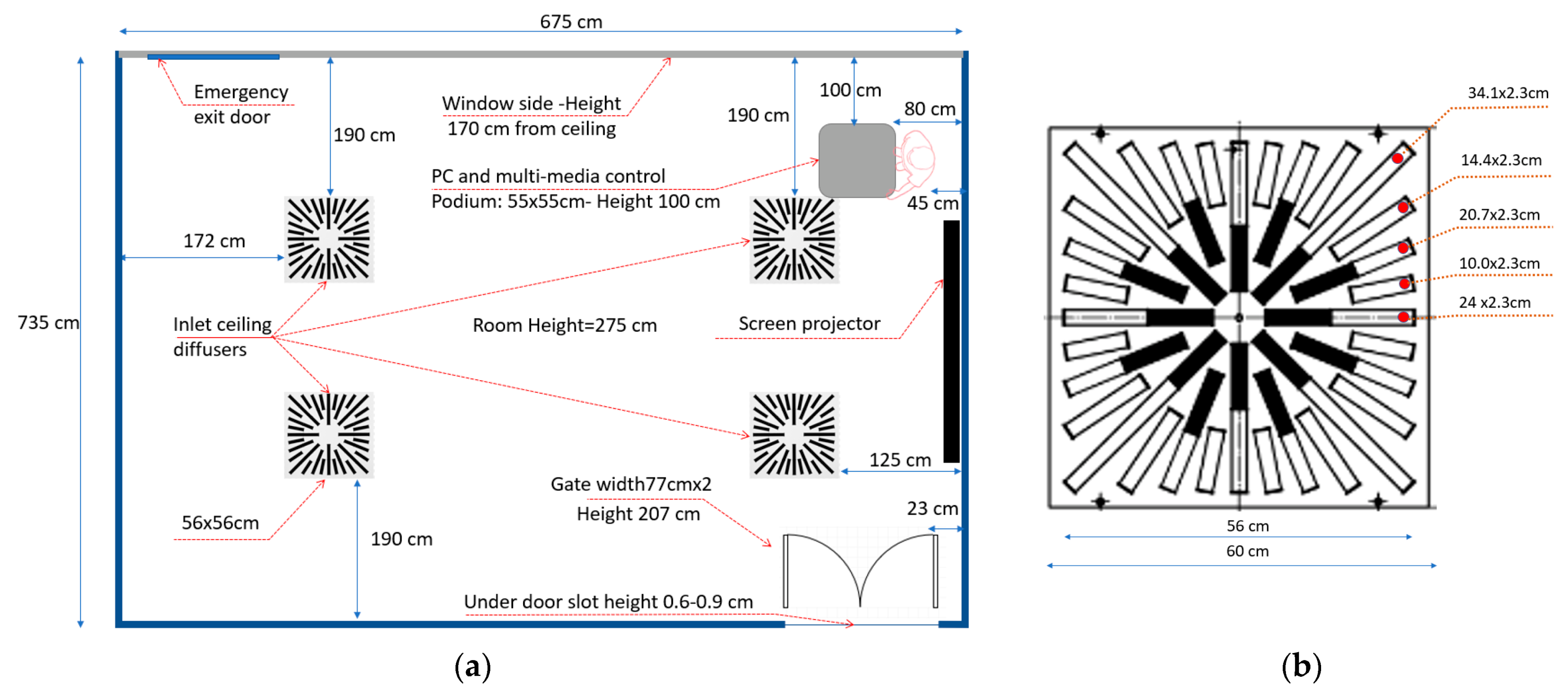
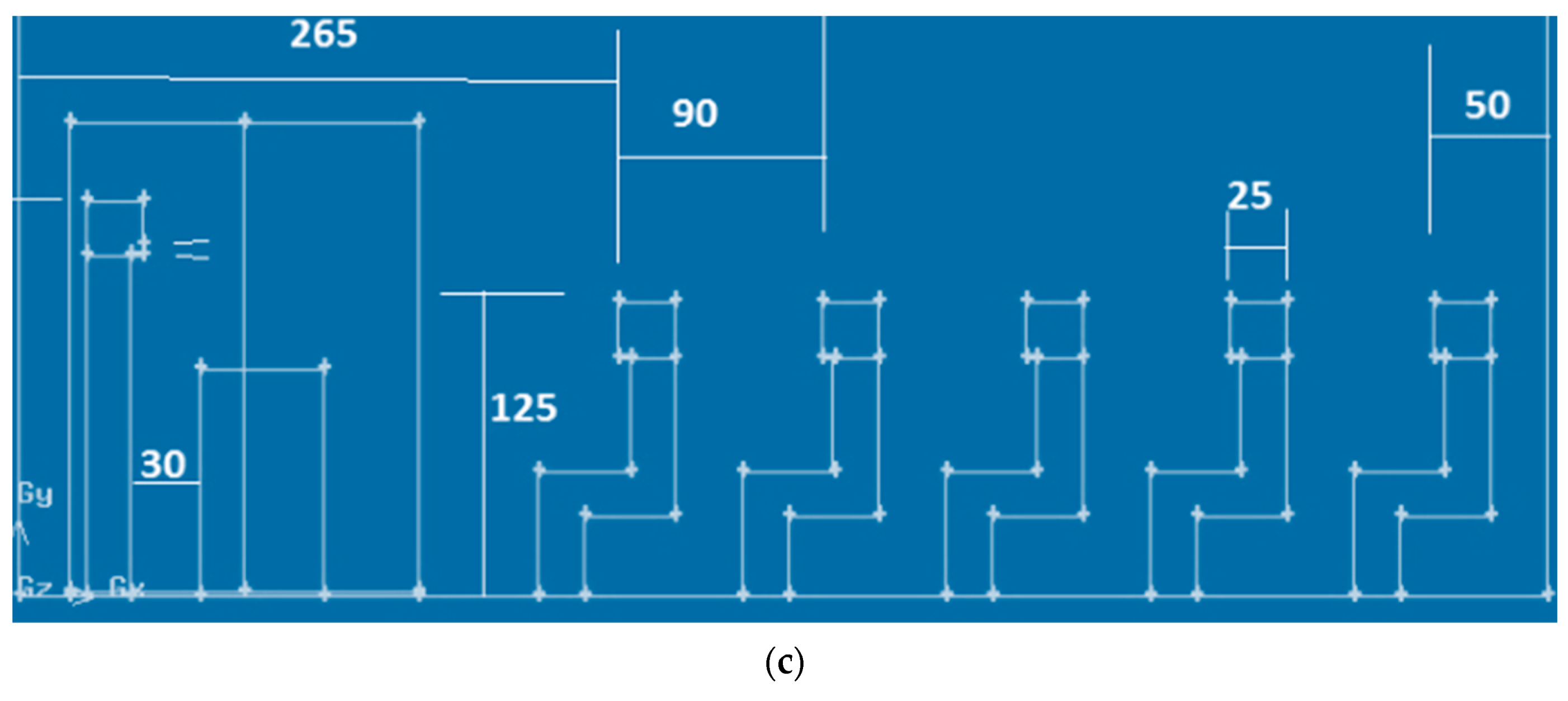
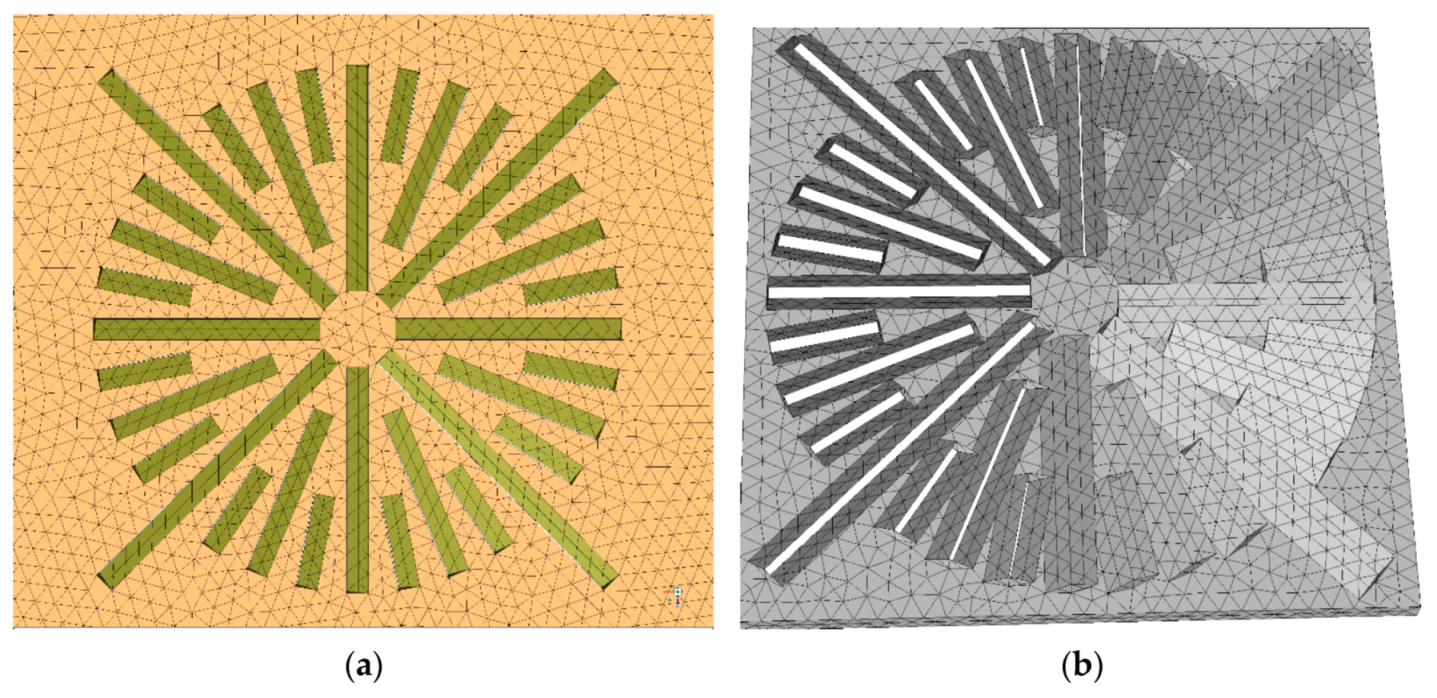


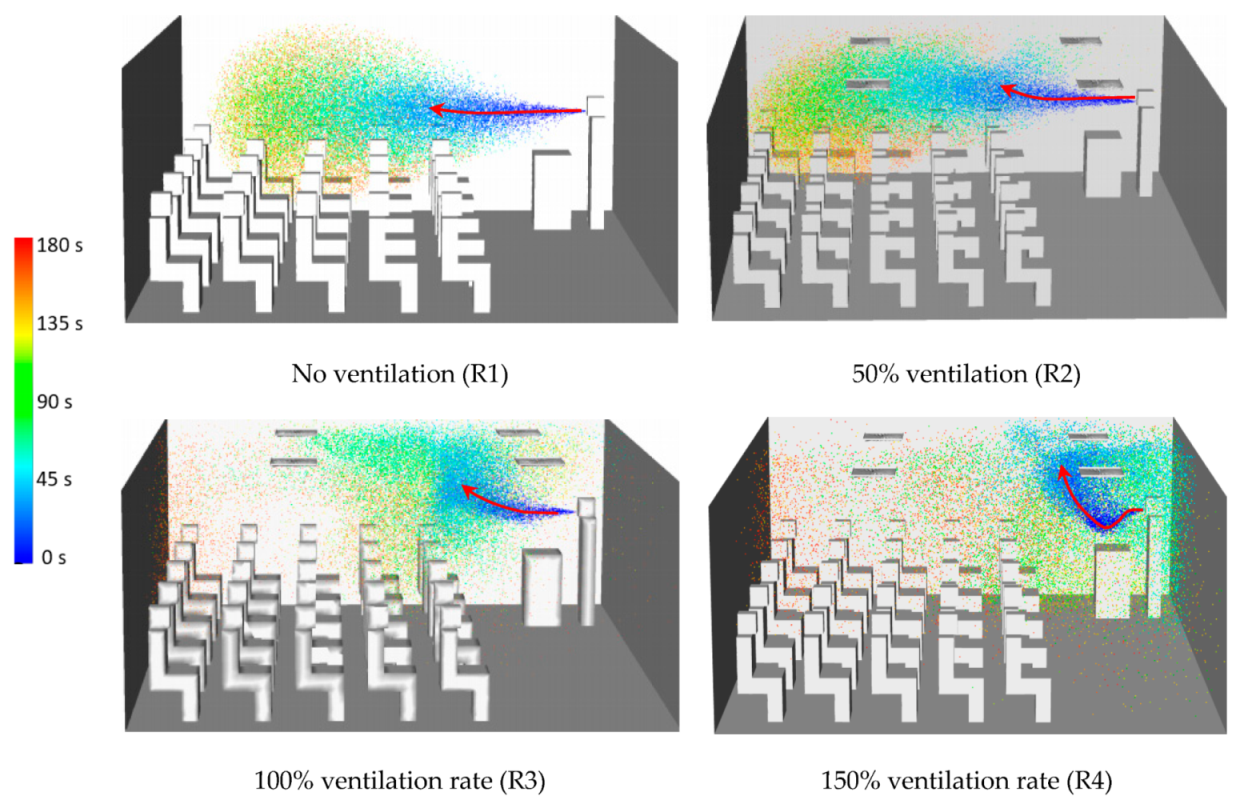
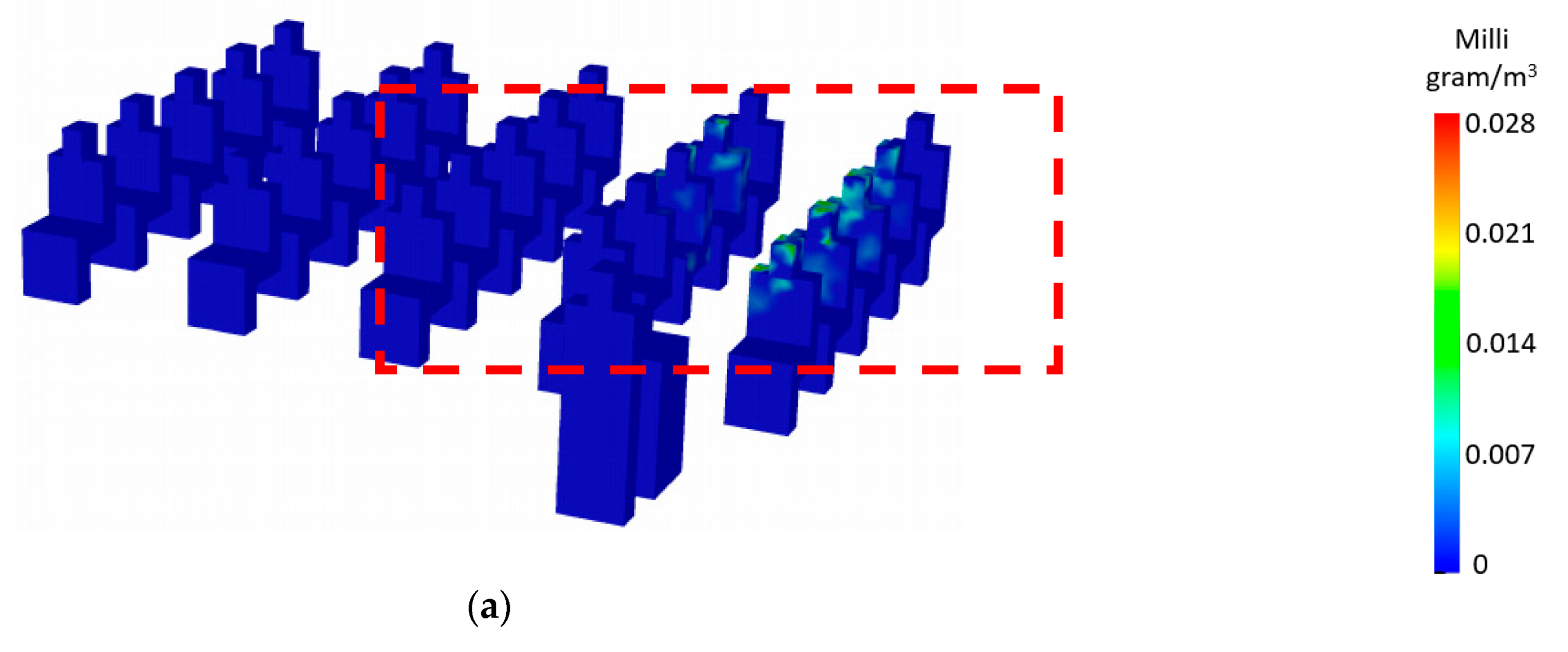
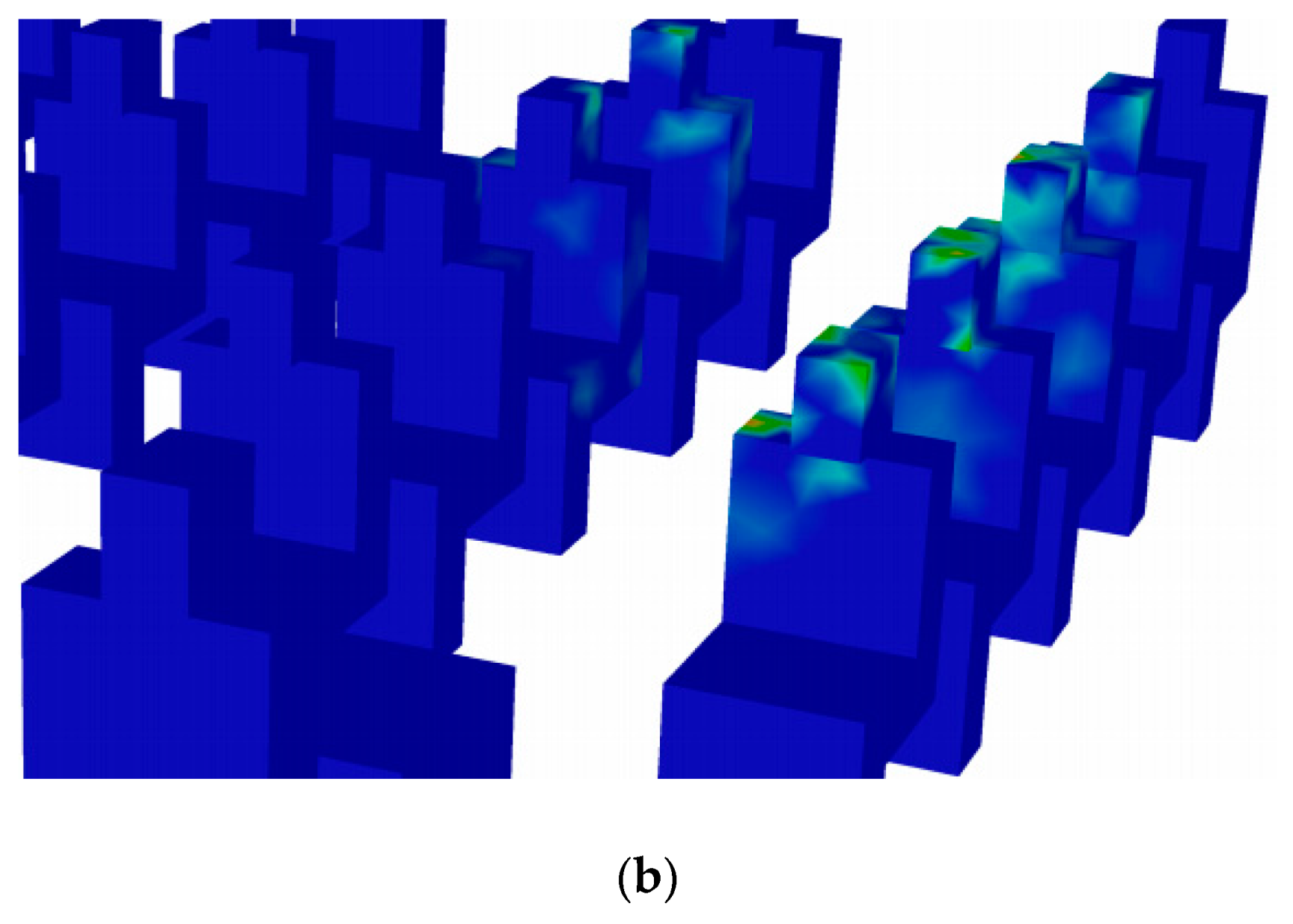
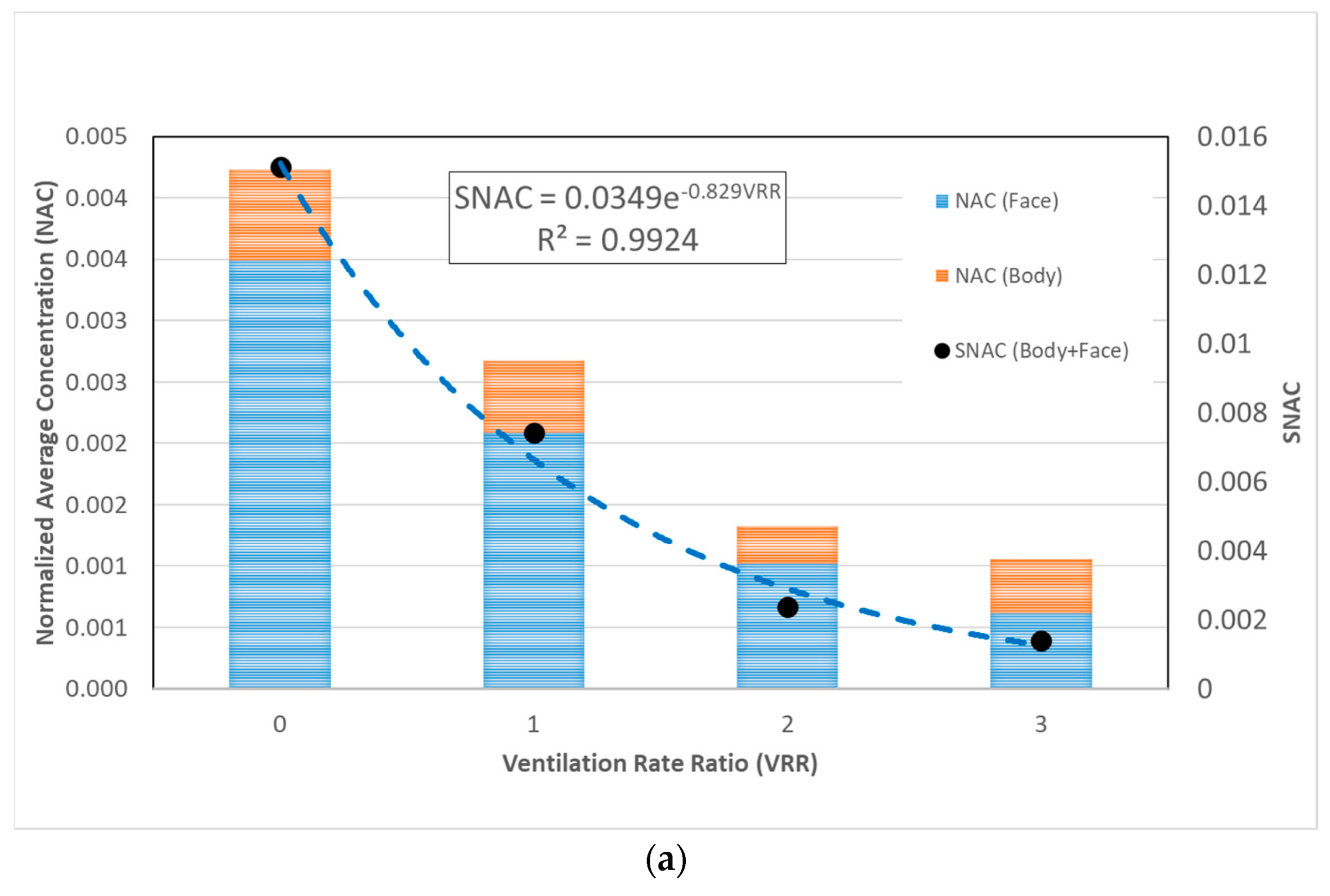
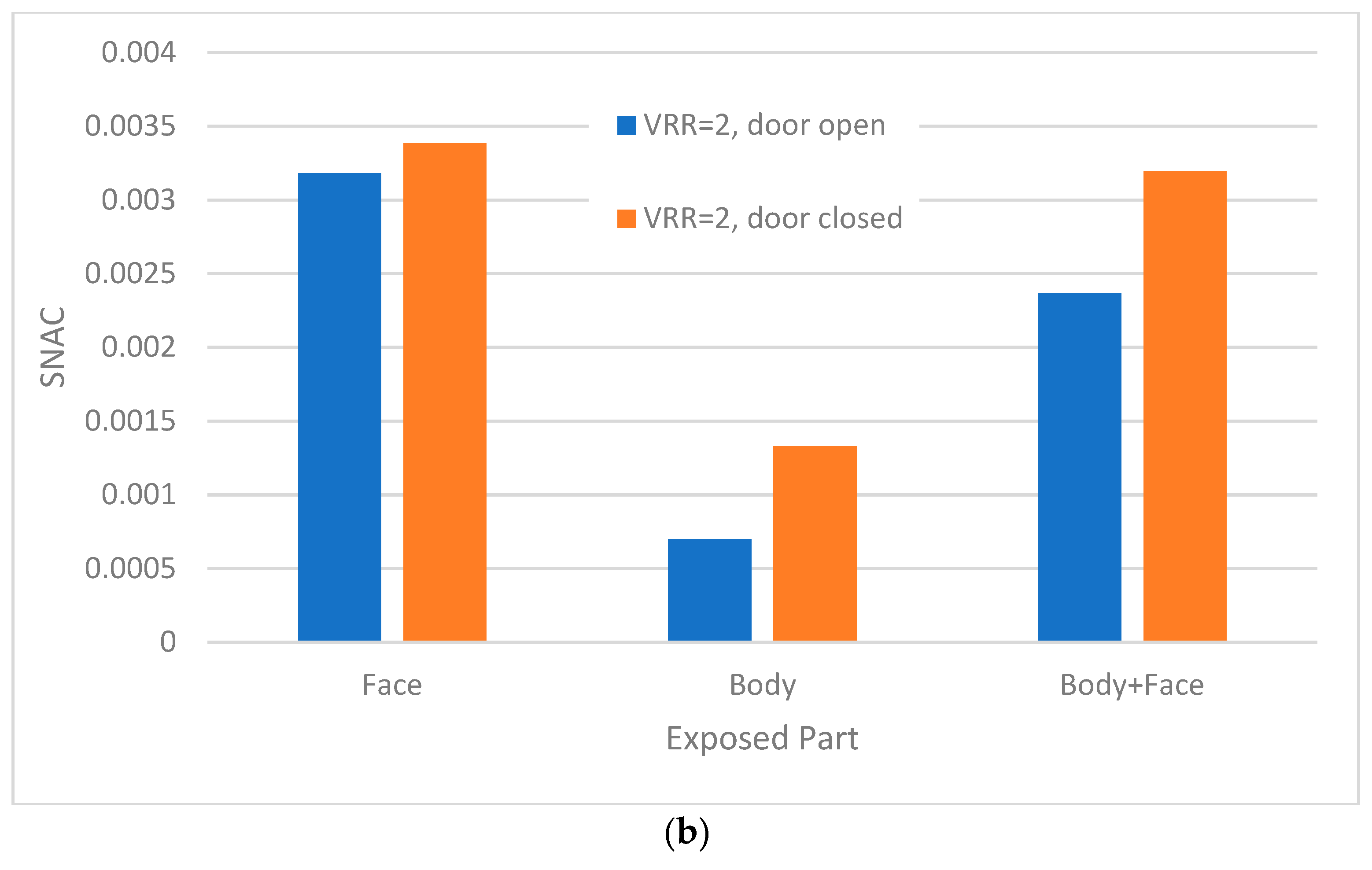
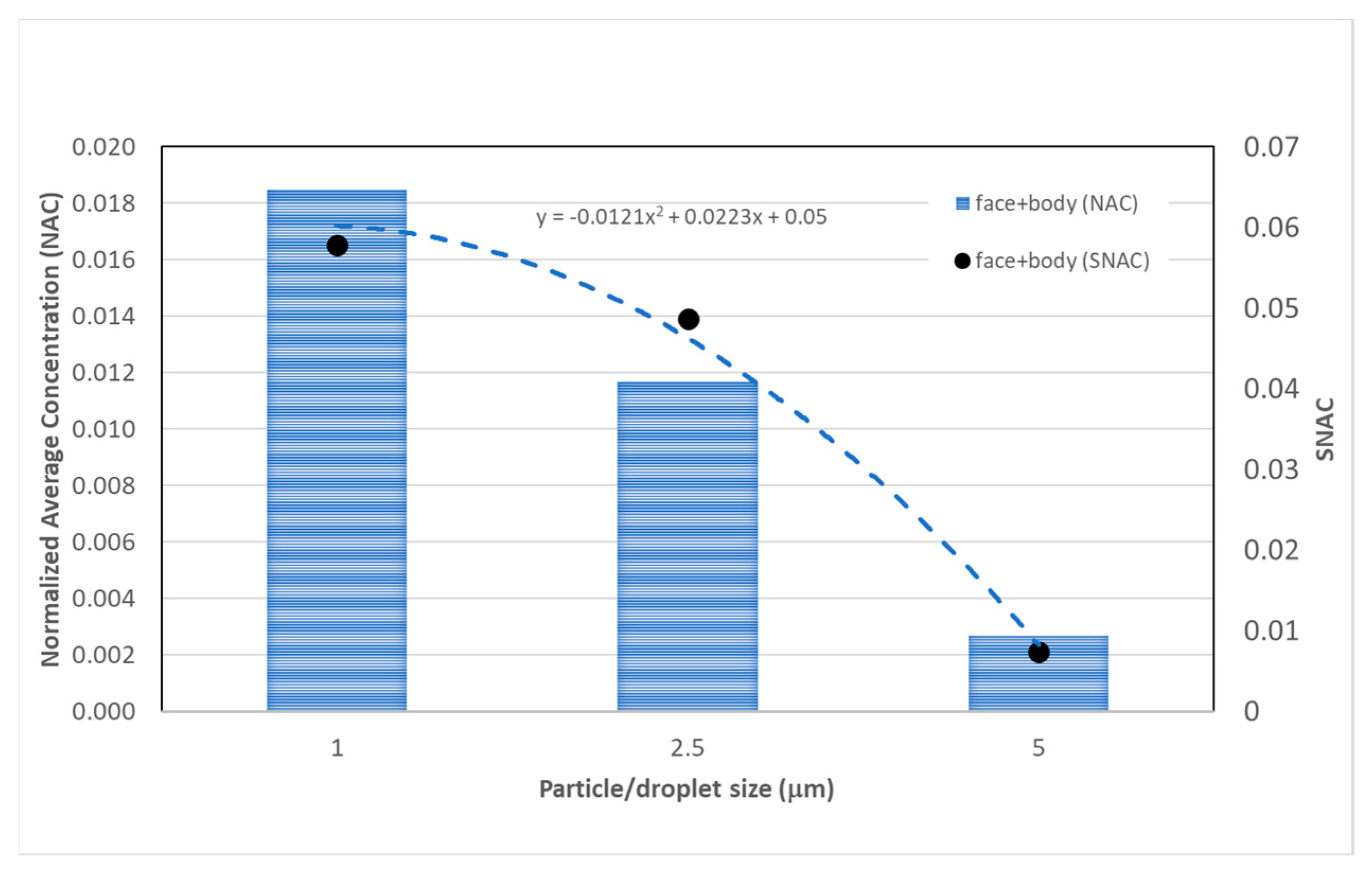
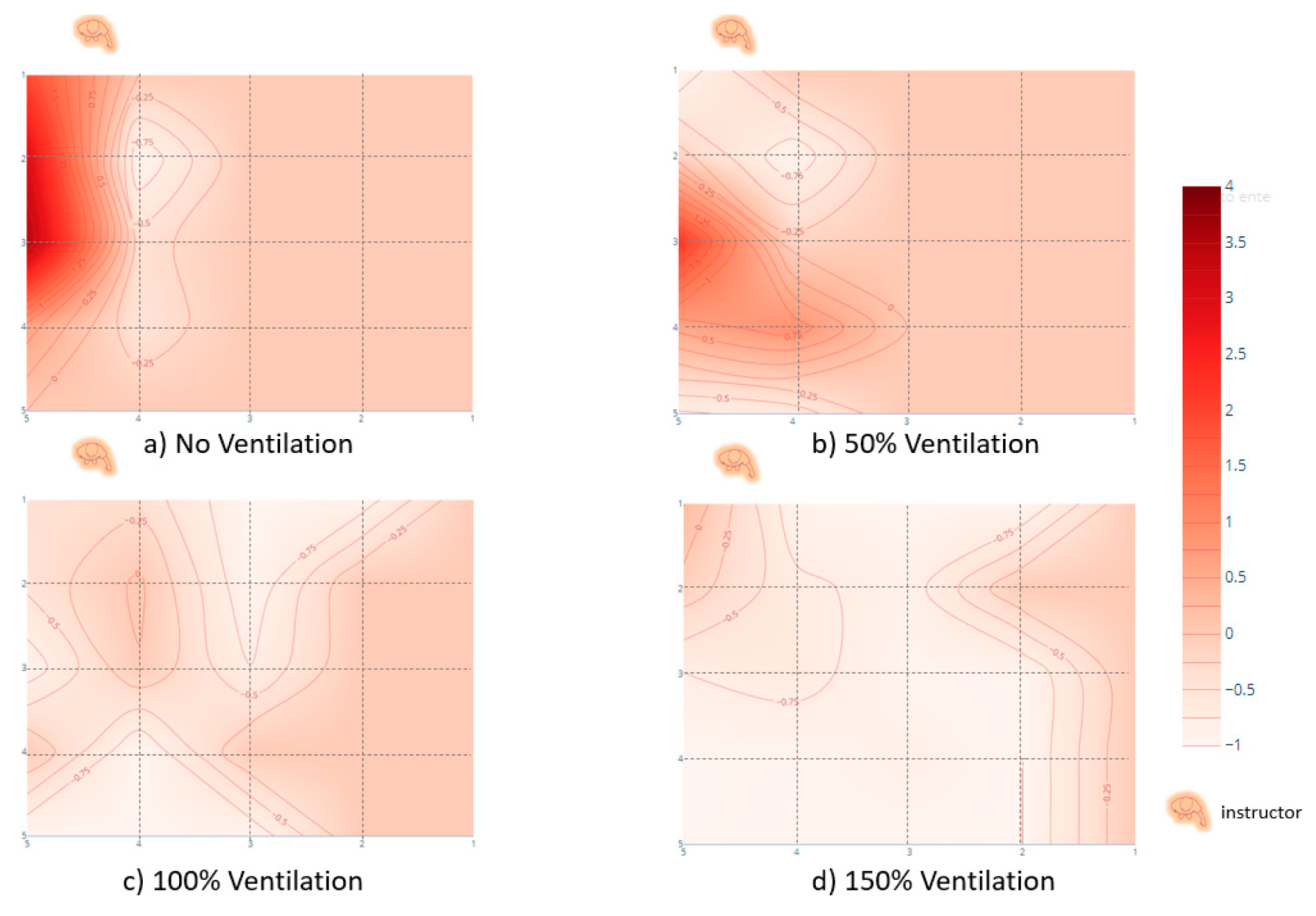
| Item | Description | Selection |
|---|---|---|
| Software | CFD Package | Fluent-Workbench 18.2 |
| Numerical Settings | Turbulence Model | k-ε (RNG) model |
| Turbulent kinetics, momentum and rate of turbulent dissipation | Second order Upwinding scheme | |
| Gradient for Upwinding | Green-Gauss Node-based Scheme | |
| Pressure-Velocity Coupling Scheme | Simple-C | |
| Meshing | Cell Shape | Tetrahedral |
| Boundary Conditions | Inlet | Velocity-inlet |
| Outlet | Pressure-Outlet | |
| Wall | Standard log-law | |
| Computing Resources | Processing speed | 3.1 GHz |
| No of used Cores | 32 | |
| No of used Core-hours | 600 |
| Scenario | Size (μm) | Ventilation Rate % | Status of Entrance Door | Comment | ||||
|---|---|---|---|---|---|---|---|---|
| No ventilation | 50% | 100% | 150% | Opened | Closed | |||
| R1 | 5 | √ | √ | emergency case | ||||
| R2 * | 5 | √ | √ | Reference case | ||||
| R3 | 5 | √ | √ | Current case | ||||
| R4 | 5 | √ | √ | |||||
| R5 | 5 | √ | √ | |||||
| R6 | 2.5 | √ | √ | |||||
| R7 | 1 | √ | √ | |||||
Publisher’s Note: MDPI stays neutral with regard to jurisdictional claims in published maps and institutional affiliations. |
© 2021 by the authors. Licensee MDPI, Basel, Switzerland. This article is an open access article distributed under the terms and conditions of the Creative Commons Attribution (CC BY) license (https://creativecommons.org/licenses/by/4.0/).
Share and Cite
Farouk, M.I.; Nassar, A.F.; Elgamal, M.H. Numerical Study of the Transmission of Exhaled Droplets between the Instructor and Students in a Typical Classroom. Appl. Sci. 2021, 11, 9767. https://doi.org/10.3390/app11209767
Farouk MI, Nassar AF, Elgamal MH. Numerical Study of the Transmission of Exhaled Droplets between the Instructor and Students in a Typical Classroom. Applied Sciences. 2021; 11(20):9767. https://doi.org/10.3390/app11209767
Chicago/Turabian StyleFarouk, Mohamed Ismail, Ahmed Fayez Nassar, and Mohamed Hassan Elgamal. 2021. "Numerical Study of the Transmission of Exhaled Droplets between the Instructor and Students in a Typical Classroom" Applied Sciences 11, no. 20: 9767. https://doi.org/10.3390/app11209767
APA StyleFarouk, M. I., Nassar, A. F., & Elgamal, M. H. (2021). Numerical Study of the Transmission of Exhaled Droplets between the Instructor and Students in a Typical Classroom. Applied Sciences, 11(20), 9767. https://doi.org/10.3390/app11209767








